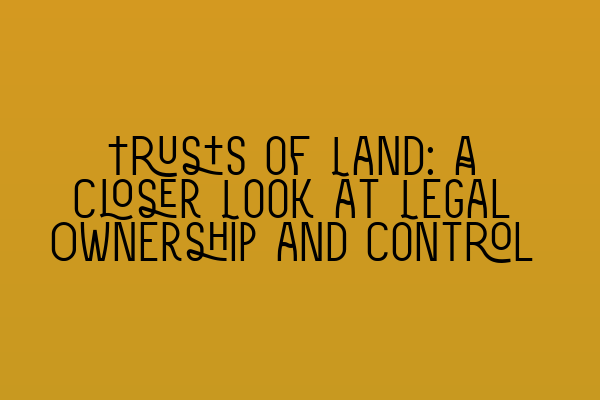Trusts of Land: A Closer Look at Legal Ownership and Control
In the fascinating world of property law, one area that often requires a deeper dive is the concept of trusts of land. Understanding the legal ownership and control mechanisms involved in these trusts is essential for solicitors and legal professionals in the field. So, in this blog post, we will take a closer look at trusts of land, unraveling the intricacies and shedding light on this complex topic.
Before we delve into the specifics, let’s briefly define what a trust of land is. Essentially, it is a legal arrangement where property is held by one party for the benefit of another party or parties. Trusts of land can arise in various situations, such as joint ownership, family arrangements, or investments. The key aspect is that the legal ownership and control are distinct from the equitable or beneficial ownership.
Now, let’s explore the different forms of legal ownership and control that arise within trusts of land.
1. Legal Ownership
Legal ownership refers to the entitlement of a person or entity to have their name registered as the owner of the property. In the case of trusts of land, legal ownership is held by the trustees. Trustees are the individuals or entities entrusted with the management and administration of the property on behalf of the beneficiaries.
It is important to note that legal ownership does not necessarily equate to beneficial ownership. The trustees may hold the legal title, but the beneficial interest in the property may belong to someone else, known as the beneficiary. This division between legal ownership and beneficial ownership is a fundamental characteristic of trusts of land.
2. Beneficial Ownership
Beneficial ownership, also known as equitable ownership, refers to the right to enjoy and benefit from the property. The beneficiaries are the individuals or entities who hold the beneficial interest in the property. They do not have legal ownership but are entitled to the benefits, such as rent, income, or use of the property.
The beneficial interests can be divided or shared among various beneficiaries based on the terms of the trust. For example, in a joint ownership scenario, the beneficial interest may be split equally between the co-owners. It is crucial to identify and understand the beneficiaries’ rights and obligations to ensure a fair distribution of interests.
3. Control Mechanisms
Within trusts of land, control mechanisms play a pivotal role in managing and making decisions regarding the property. The trustees hold the legal power to control and manage the property, subject to any trust provisions or legal restrictions. They are responsible for maintaining and protecting the property, dealing with any disputes, and making decisions in the best interests of the beneficiaries.
However, the trustees’ control is not absolute, as they have a fiduciary duty to act in the best interests of the beneficiaries. They must exercise their powers in accordance with the terms of the trust and the principles of equity. This duty ensures a level of protection for the beneficiaries and safeguards their interests in the property.
In addition to the trustees, the beneficiaries may also exercise control over certain aspects of the property. For instance, they may have the right to occupy or use the property or have a say in major decisions affecting the property. These control mechanisms are typically outlined in the trust instrument or established through legal principles and case law.
By understanding the nuances of legal ownership, beneficial ownership, and control mechanisms within trusts of land, solicitors and legal professionals can effectively navigate the complexities of this area of law. This knowledge enables them to provide accurate advice, facilitate fair transactions, and protect the interests of their clients.
If you’re interested in exploring more topics related to property law or preparing for your SQE exams, we have a range of helpful resources and courses available. Check out our SQE 1 Practice Exam Questions and SQE 1 Practice Mocks FLK1 FLK2 articles for valuable practice materials. For comprehensive preparation, our SQE 1 and SQE 2 Preparation Courses offer expert guidance and support. Stay updated with the latest SRA SQE Exam Dates to plan your study schedule effectively.
In conclusion, trusts of land involve a unique interplay of legal ownership and beneficial ownership, with control mechanisms balancing the rights and responsibilities of trustees and beneficiaries. It is through this delicate equilibrium that trust arrangements achieve their intended purposes. As legal professionals, having a deep understanding of these intricacies is crucial to providing quality advice and ensuring the fair treatment of all parties involved.
